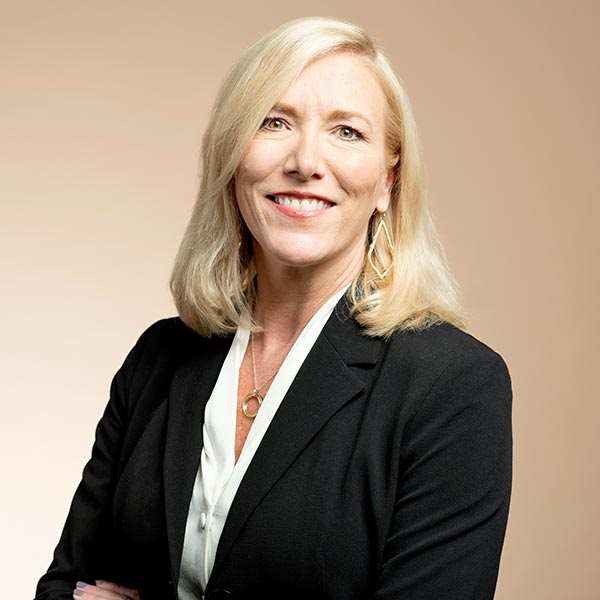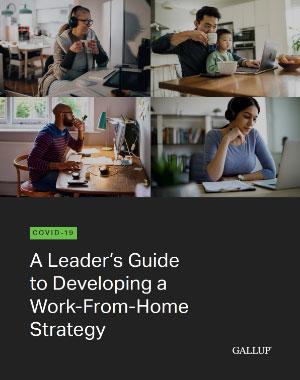A Conversation With Lisa Britt

Lisa Britt
Chief Human Resources Officer and SVP at Thermo Fisher Scientific
CliftonStrengths Top 5: Strategic | Responsibility | Relator | Arranger | Activator
When the pandemic hit, Thermo Fisher Scientific sent everyone who was not responsible for production or essential activity support home to work -- bouncing the company's remote rate from less than 20% to nearly 60% overnight. Today, about 30% of that pandemic-related "work-from-home workforce" is back on-site, which is significantly lower than the post-pandemic in-house rate Thermo Fisher is aiming for. "You have to come back together when it is safe to do so," says Thermo Fisher's CHRO and SVP, Lisa Britt. "There are some critical things that are better done together."
One of those critical things, Britt says, is efficient collaboration. "Our 80,000 colleagues deliver an unrivaled combination of innovative technologies, purchasing convenience and pharmaceutical services. Customers depend on Thermo Fisher's innovative, fast, high-quality solutions." And that, according to Britt, requires trust and collaboration -- and proximity is key to both.
Still, Britt says expectations for greater flexibility are the norm, so Thermo Fisher is actively working to enable flexible and hybrid work opportunities where appropriate, and in the company's and employees' best interests. But as she relates in this CHRO Conversation, "We are a team. Teams must come together at times, and purposeful proximity matters."
Emond: Thermo Fisher Scientific kept an unusually high number of employees on-site. What are your plans now?
Britt: That's right, the essential work performed by our company was necessary and the additional colleagues who have returned to the workplace have done so in a safe and thoughtful manner. We support our customers to accelerate life science research, improve patient diagnostics and solve complex analytical challenges through our products and services, and it requires what we call "purposeful proximity." In March 2020, we reduced our on-site workforce to those who were critical to meeting customer needs, which represented about half our workforce, at first. Today, between 30% and 40% of the work from home population are engaging with their work site on a weekly basis and in compliance with government density mandates. We're very, very careful and are working with experts and continuing to invest significantly in health and safety protocols to make our sites safe for our colleagues, as you would expect from a company like ours. Post-pandemic, we'll have more flexible work opportunities than we had pre-pandemic. It's not our goal to immediately restore full capacity -- but proximity is absolutely part of our secret sauce. It enables people to build trust, which is very difficult to do effectively while working virtually, and as we continue to grow rapidly, hiring people as fast as we need to, things slow down when you're not able to build trust the way you are accustomed to.
Emond: What factors lie behind that return-to-work decision?
Britt: We are a rapidly growing company, and that means we are constantly hiring to support our growth. With many new hires expected, we need to join them into the company thoughtfully so they can understand our mission, understand what we're doing, be able to prioritize and quickly feel like they belong here. Proximity is a critical component of that for us. We have more remote work now than in the past and we will continue to have remote workers, perhaps more so than pre-pandemic. That's definitely part of our "future of work" design. We're affording flexibility where it makes sense and supports colleague work-life balance, but we're not sacrificing the things that have made us successful over the years. We have many work teams whose effectiveness would certainly be diluted over time in a sustained remote environment. R&D, marketing, and business-enabling partners are just a few examples of groups whose impact is reduced when remote. And there are customer-facing roles in our sales organizations for which it's not just about coming back to work, it's about getting back out to work. We've enjoyed the new access through virtual channels, and we will operationalize the things that have proven even more effective than before. However, it's not the same as being able to sit with a new customer, walk through the product or capabilities story, and demonstrate that product and its efficacy in the client's environment. Virtual reality can only provide so much. Nothing really replaces the ability to collaborate in a room and build trust and confidence.
It's not our goal to immediately restore full capacity -- but proximity is absolutely part of our secret sauce. It enables people to build trust, which is very difficult to do effectively while working virtually, and as we continue to grow rapidly, hiring people as fast as we need to, things slow down when you're not able to build trust the way you are accustomed to.
Emond: And those things build trust …
Britt: Yes, and when you have trust, you can have speed. So, we're purposefully selecting where proximity absolutely matters within our organization for our culture now and in the future. A company culture should be purposeful, rather than happening by chance. The faster we can acclimate a new colleague to Thermo Fisher and ground them in our mission -- why we exist, why we do what we do, why we act the way we act, why we value the things we value -- the sooner that colleague will be able to make meaningful contributions. I have found that proximity matters significantly more for new colleagues than those who have established relationships, organizational agility and trust. One point I want to make, and it likely represents the way many companies feel, is that over the past year, we've really drawn down on what we've called the "trust bank." We've been depositing in the trust bank based on proximity-driven, cultivated workplace relationships for years. We knew how to get things done in the company based on our experience in the company. We've been withdrawing from that account over the past year, without making as many necessary new deposits. We were equipped to be successful -- arguably, as successful as we've ever been -- in this past year, but the questions we ask ourselves are "How long can you sustain it before experiencing a negative impact, and could we repeat it? Could we do so if 10%, or perhaps 20%, of our people were new, people who don't yet know how to operate efficiently and quickly, in our environment?" That's compelling for us because we don't want to take culture and experience for granted -- we don't want to say if we did it once, we could do it twice. I'm very sensitive to that and to the concern that, before we know it, we could lose what makes us such a special company. Negative cultural impact will be much harder to recoup if we're not able to recognize it before there's potentially some negative impact on our culture, our business, our future, our ability to innovate, to meet our customers' expectations. I'd rather be the outlier on the future of long-term remote work than to take that risk.
Emond: How are you deciding the stages of return?
Britt: We're watching the data carefully, and the answer depends on certain variables. Our back-to-new-normal plan will be driven at a very local level and depends on local government orders, community infection rates, internal incident rates, vaccine prevalence and colleague testing. Right now, beyond the essential workers, those who have continued to come to work are generally the people who want to be on-site. We've created safe, clean spaces for those who want or need more proximity and a direct connection to the culture or are involved in innovation activity. As the data supports it, we will continue to safely increase density in our sites. So, unless by a preapproved flexible work arrangement or perhaps a medical accommodation, colleagues will be expected to return to the workplace. That's the key -- when the data supports it, we need our colleagues to connect back to the workplace in a purposeful way. Right now, as an example, 30% to 40% of the site workforce is connecting at our corporate headquarters for at least two days a week to stabilize and scale support services, such as cafeteria, security, cleaning and sanitation. If incidence rates internally and in the local market remain low or further decline, we will adjust to three days a week, and so on. Eventually, we will look far more like we did before COVID-19 than we look today. That's not to say we won't also deliberately embrace flexible and remote options where proven effective, where our colleagues really want it, and where it makes us more competitive. However, we won't do it at the expense of the company's future.
A company culture should be purposeful, rather than happening by chance. The faster we can acclimate a new colleague to Thermo Fisher and ground them in our mission -- why we exist, why we do what we do, why we act the way we act, why we value the things we value -- the sooner that colleague will be able to make meaningful contributions.
Emond: Where is Thermo Fisher going with [COVID-19] testing for the long term? Where do you think other companies are going to go?
Britt: In the U.S., we're generally testing at least once a week in every site with more than 50 people, in states that support surveillance or diagnostic workplace testing. Europe is a bit more challenging given the strict data privacy laws and testing thus far has been more driven by local governments. Testing in our Asia Pacific and China geos has also been governmentally driven where COVID-19 cases have remained very low for several months now. So, until there's no need for it, we'll continue to provide colleague testing in the U.S. We, and many other employers, will likely use testing to safely bring large groups together, even when the infection rate is sustainably low, and the vaccination rate is up -- just as an additional safeguard. We'll follow the science, as you would expect, and right now incidence rates, testing, vaccination rates and local density mandates drive our plans. As soon as those points coalesce, hopefully sooner than later, we'll be back to a more normal environment. That will probably be our approach until we see a full societal recovery.
Emond: So, at the end of the day, you'll mostly be together in person, yes? What do your employees think?
Britt: The short answer is yes. However, I think if you told our workforce that they have to immediately come back to exactly what work was, there would be disruption and unnecessary turnover, so we will adapt in line with our cultural values and needs. I also think people who choose to do the work that we're doing recognize the value of proximity when it's clearly articulated. Many of our colleagues, probably most of them, self-select into this industry and understand the power of a collaborative culture. We will continue to strive to be one of the world's most admired companies and to create great work experiences, and all that entails, for our colleagues.
Emond: Good point. Scientists are accustomed to working in a team environment.
Britt: Absolutely. Teams, in general, are an accelerator for us, and if you have to learn everything by making mistakes on your own, life's hard. We create value by transforming collaborative knowledge into products and services for customers. It's really very hard to do that just working on your own. We learn something from every colleague and from every idea. So we're making appropriate changes for our future, and it's not one-size-fits-all but, for us, proximity is important.
Emond: Are there particular types of roles that don't require so much proximity?
Britt: Yes, there are many roles in information technology and data science, and our U.S. customer service support teams who have previously been based in call centers, those can be performed from anywhere.
We create value by transforming collaborative knowledge into products and services for customers. It's really very hard to do that just working on your own. We learn something from every colleague and from every idea. So, we're making appropriate changes for our future, and it's not one-size-fits-all but, for us, proximity is important.
Emond: Not many companies are bringing their call center people back to shared service centers.
Britt: For this business, space constraints and the nature of the varied external interactions made the customer service team a great option for "anchored remote work." This means they work remotely regularly but, when required, have easy access to their local work site and the broad team for on-site collaboration and professional development.
In some cases, such as the information technology example, we would have more access to talent in lower-cost areas of the country, access to more diverse candidates, and colleagues who could cover across more time zones. They could come to a work site on a routine basis for things that we need them to do together -- purposeful proximity.
Emond: The space consideration can be a challenge. How are you planning to enable flexibility?
Britt: Well, there isn't a single answer we've found, but we have reinforced that flexibility must work for both the colleague and the company. For example, if you are approved for a schedule that supports remote work for more than two workdays per week, then you'd sign up for hoteling space instead of having a dedicated workspace. In that way, we prioritize our physical footprint for those who need it or prefer it. But that brings up the question of leadership capability.
Emond: How so?
Britt: For many managers, managing a variety of proximity wants and needs is a real challenge and a capability requiring more development. Whether their workforce is fully distributed -- which is an extreme -- hybrid, or flexible, or all of the above, managers are required to lead differently than they did a year ago. Investing in this development is important and we must equip managers with the tools necessary to support the evolving needs within our culture. Further, colleague wellbeing is at the forefront and managers need to be attuned to work-life balance challenges to ensure colleagues are "working from home," not "living at work." It's clear that creating and sustaining balance has been a real challenge this past year; managers must be more aware and address colleague needs more than ever before.
Emond: So how are you, yourself managing?
Britt: While still in pandemic recovery, I'm trying to role model what I'm asking other people to do. I go to the workplace regularly, and I work from home at least once a week to demonstrate my commitment to the safety of our workplace as well as the needed flexibility. Many executives share this approach including our CEO, and this reinforces that it can be done well. I do look forward to the time -- hopefully soon -- when we can safely bring our teams together more fully. Delivering on our company mission -- enabling our customers to make the world healthier, cleaner and safer -- has never been more essential.
In the end, our future of work may look a little different than we expected it would back in 2019, and we are committed to being an even better company from 2021 forward. To do so, we need to build on who we are. Our success is driven by great talent working interdependently -- transforming the best ideas into new innovations. We will carry this fundamental forward with purposeful proximity, while recognizing that, in many cases, proximity is powerful.
Explore other CHRO conversations:
- IBM CHRO Nickle LaMoreaux
- Standard Chartered Bank Group Head of HR Tanuj Kapilashrami
- Zurich Insurance Group CHRO David Henderson
- AT&T CHRO Angela Santone
- Merck KGaA CHRO Dietmar Eidens
- Eli Lilly Senior VP of HR and Diversity Steve Fry and Chief Diversity Officer Joy Fitzgerald
- Schneider Electric CHRO Olivier Blum
Jennifer Robison contributed to this article, which was based on an interview conducted by Larry Emond.



